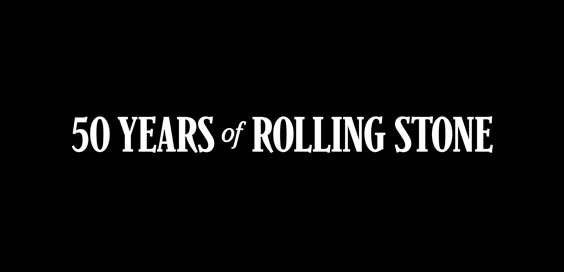50 Years of Rolling Stone: The Music, Politics and People that Changed Our Culture – Review

By Richard Jones
It was the year of the Summer of Love, and although unemployed 21-year-old San Francisco graduate Jann S Wenner had a passion for the groundbreaking music coming out that year, he wanted to create a magazine that took rock ‘n’ roll seriously.
The first issue of Rolling Stone magazine rolled off the presses on November 9, 1967.
To get it off the ground, Wenner had borrowed $7,500 from his family and the parents of his soon-to-be wife, Jane Schindelheim, and worked on the publication using donated office space and old typewriters.
In the first issue, Wenner explained that the title of his magazine referred to the 1950 blues song, ‘Rollin’ Stone’, recorded by Muddy Waters, rock ‘n’ roll band the Rolling Stones, and Bob Dylan’s hit single ‘Like a Rolling Stone’.
In May 2017, almost five decades on from the first issue of Rolling Stone, the Rock and Roll Hall of Fame in downtown Cleveland, Ohio, unveiled a sprawling new exhibition.
Spread out over the top three floors of the museum, it explores the magazine’s significant impact on music, culture, journalism and the world over the past 50 years.
 “The book moves through the last five decades, giving equal coverage to each”
“The book moves through the last five decades, giving equal coverage to each”
Its opening also corresponds with the publication of 50 Years of Rolling Stone: The Music, Politics and People that Changed Our Culture, a glossy, hardback book documenting the magazine’s history, decade by decade, in words and photographs.
Not only does this landmark book document the magazine’s rise to prominence as the voice of rock ‘n’ roll, it is also a reminder of how Rolling Stone became, and still is, a showcase for era-defining photography.
After the personal introduction written by Wenner, the book moves through the last five decades, giving equal coverage to each.
The 1960s saw a seismic change in society and music, and Rolling Stone‘s covers during this decade sum up the shifting moods in America and around the world. The opening chapter includes features on Pete Townshend, Woodstock, The Groupies, Other Girls and American Revolution 1969.
From a historic point of view, this is probably the most interesting section, as it not only outlines the decade of social revolution, it also perfectly encapsulates the beginnings of the magazine itself.
By the end of the 1970s, Rolling Stone had moved from its original home in San Francisco to New York, and world-class photography, particularly that of Annie Leibovitz, had become an integral part of its output.
“Interesting and sobering”
This section contains pieces on Finding Patty Hearst, The Death of Karen Silkwood, The Family – A Photo Portfolio by Richard Avedon, John Lennon, Charles Manson, Sex Pistols, Ralph Steadman and Hunter S Thompson.
Gonzo journalist Thompson is referred to a lot in this book, and understandably so. He first published his most famous work Fear and Loathing in Las Vegas within the pages of Rolling Stone, where he remained a contributing editor until his death in 2005.
Probably because of my age, but also due to the quality and style of photography in the chapter, the 1980s is my favourite section in this book. The part about John Lennon’s death at the beginning of the decade is particularly interesting and sobering – the murder hit Wenner and his staff pretty hard.
Guns N’ Roses, Keith Richards, Tom Wolfe, The Devil and John Holmes, Inside the AIDS Epidemic, David Letterman and Michael Jackson all feature in the chapter dedicated to the magazine’s third decade.
There are two startling images of Jackson in the book – 20 or so pages apart which show his ‘transformation’ from the cherubic singer in Jackson Five to the worldwide pop phenomenon, and some would say caricature, he would later become.
“Reputation was legendary”
Moving onto the 1990s, and the magazine underwent change as new musical styles such as grunge and gangsta rap came to the fore.
Chapters on Eminem, Jerry Garcia, Mick Jagger, PJ O’Rourke on Government Waste, Marilyn Manson, Kurt Cobain, Madonna Flesh and Fantasy, A Photo Portfolio by Steven Maeisel, Fast Food Nation and Mandatory Minimums tell the tale of the Bill Clinton-inspired post-war generation taking over from the established order in America.
By the 2000s, Rolling Stone’s reputation was legendary, however, in a post-9/11 world increasingly shaped by social media, the magazine faced challenges remaining current moving into the new millennium
This section contains articles entitled: Bono, Matt Taibbi’s “Great Vampire Squid”, The Osbournes, Bob Dylan, David Foster Wallace, Inside Scientology, The Genesis Project: A Photo Portfolio by Sebestiao Salgado.
The final chapter in the book, The 2010s, which although only two thirds completed, provides yet more memorable moments, as Rolling Stone competed with online as well as print rivals. Politics has taken a more central role in the magazine, with the issues such as climate change driving much of the editorial content.
There are articles on and interviews with Kendrick Lamar, Taylor Swift, The Downfall of Gen Stanley McChrystal, Goodbye Miami, Lady Gaga and Bruce Springsteen, as well as the thoughts of former US President Barack Obama.
“Interviews with rock legends”
Almost A3 size and 288 pages long, 50 Years of Rolling Stone is not the kind of book you can carry around. It is a heavy souvenir keepsake which one buys as a gift for someone, or yourself, and sits proudly on the coffee table or the bookshelf.
It contains interviews with rock legends such as Dylan, Jagger, Cobain and Springsteen, but their words are given extra meaning and colour when paired with Leibovitz, Baron Wolman or Mark Seliger’s iconic photographs.
“If you look at rock ‘n’ roll, it was about the visuals,” Wenner has said. “A lot about the sex appeal and the fashion and the style. And so, seeing these people, and shooting them right, and showing that side of the music was really, really important.
“Early on, I said we just can’t be running pictures of people in performance with a black background and a microphone in their face.
“We have to shoot original, studio portraits of people. We started off right away doing that.”
“An irresistible and essential keepsake”
The book is a feast for the eyes. As well as being difficult to lift up, it is also hard to put down – you can’t resist turning the page to see the next photograph of, or interview with, an iconic pop culture icon.
For the past five decades, Rolling Stone has been a leading voice in journalism, cultural criticism, and – above all – music.
As Wenner wrote in editor’s note for the first edition: “Rolling Stone is not just about music but also the things and attitudes that the music embraces.”
This book is an irresistible and essential keepsake of the magazine that has defined American music for generations. In the age of the internet, Rolling Stone remains an exception – a print magazine that is ahead of the news, often making it.
Here’s to the next 50 years.
’50 Years of Rolling Stone: The Music, Politics and People that Changed Our Culture’ by Rolling Stone and Jann S. Wenner (Abrams, out now, £45)










